DOi:10.16111/j.0258_7106.2017.05.003
黑龙江省多宝山Cu_Mo矿床成矿斑岩锆石U_Pb年龄及地球化学特征
(中国地质科学院矿产资源研究所 国土资源部成矿作用与资源评价重点实验室, 北京10 0037)
第一作者简介刘军, 男, 1983年生, 博士,副研究员, 矿床学专业。 Email: junl iu@yeah.net
收稿日期2016_08_05
本文受国家重点研发计划项目(编号: 2017YFC0601403)、国家自然科学基金项目(编号 : 41172081)和中国地质调查局地质调查项目(编号: 12120113093600)联合资助
摘要:多宝山矿床位于大兴安岭北部,是中国东北地区规模最大的斑岩型Cu_ Mo矿床。文章对该矿床中与成矿关系密切的花岗闪长斑岩进行了详细的LA_ICP_MS锆石U_Pb 定年、主量 元素、微量元素及Hf同位素研究。结果表明,花岗闪长斑岩的LA_ICP_MS锆石U_Pb年龄为(4 74.9±1.8) Ma,其w(SiO2)为70.73%~73.45%,w(K2O)和w(N a2O)分别为2.99%~3.88%、3.86%~4.38%,属高钾钙碱性系列。岩石富集轻稀土元 素,(La/Yb)N=6.32~12.76,显示出Ba、K、La、Sr、Zr、Hf、Sm等元素富集,Th、T a、Nb、Ce、P、Ti等元素亏损的特征。锆石εHf(t)值介于10.3~14.6。 详尽的元素和同位素地球化学特征表明多宝山 花岗闪长斑岩可 能形成于大陆边缘弧环境,来源于加厚陆壳条件下亏损地幔新增生的年轻地壳物质的部分熔 融过程。
关键词:
地球化学;锆石U_Pb定年;Hf同位素;花岗闪长斑岩;多宝山矿床
文章编号: 0258_7106 (2017) 05_1057_17 中图分类号: P618.41; P618.65 文献标志码: A
Zircon U_Pb dating, geochemistry of ore_bearing porphyry in Duobaoshan Cu_Mo
d eposit, Heilongjiang Province, China
d eposit, Heilongjiang Province, China
(MLR Key Laboratory of Metallogeny and Mineral Assessment, Institute of Mineral Resources, Chinese Academy of Geological Sciences, Beijing 100037, China)
Abstract:The Duobaoshan deposit, located in northern Da Hinggan Muntains, is the largest porphyry Cu_Mo deposit in Northeast China. In this study, the authors report LA_ ICP_MS zircon U_Pb age, major, trace elements, and Hf isotopic compositions of t he ore_related granodiorite porphyry in the Duobaoshan deposit. LA_ICP_MS zircon U_Pb dating yielded crystallization age of (474.9±1.8) Ma for the granodiori te porphyry. Geochemical results indicate that the w(SiO2) values are in the range of 70.73%~73.45%, whereas w(K2O) and w(Na2O) r ange from 2.99% to 3.88% and from 3.86% to 4.38%, respectively, suggesting that the rocks belong to high_K calc _a lkalne series. The trace elements are characterized by enrichment of Ba, K, La, Sr, Zr, Hf, Sm, and depletion of Th, Ta, Nb, Ce, P, Ti. The REE characteristics are LREE enrichment with (La/Yb)N ratios of 6.32~12.76. The zircon Hf isoto pe analysis shows εHf(t) values vary from 10.3 to 14.6. The geochem ical results indi cate that the Duobaoshan granodiorite porphyry was probably formed in a continen tal marginal arc setting, and originated from partial melting of juvenile lower crust materials that were derived from the depleted mantle under the thickened c rust condition.
Key words:
geochemistry, zircon U_Pb dating, Hf isotope, granodiorit e porphyry, Duobaoshan deposit
多宝山斑岩型Cu_Mo矿田位于大兴安岭北段,主要由多宝山大型斑岩铜(钼)矿床、铜山大 型斑岩铜(钼)矿床、三矿沟小型矽卡岩铁铜矿床、关鸟河小型矽卡岩白钨矿矿床及小多宝 山 、跃进、育宝山铁铜矿点等组成,是中亚造山带东段最重要的斑岩型铜矿床聚集区(杜琦等 ,1988;韩振新等,2004;武广等,2009;刘军等,2009;Liu et al., 2012;2017)。近 年来,区域上又陆续发现了小泥鳅河金矿、三道湾子金碲矿、争光金矿、铜山金矿、上马厂 金矿等一批热液脉型金银钼锑矿床或矿化点(谭成印等,2010),使得多宝山地区成为大兴 安岭地区又一重要的金矿集中区。多宝山矿床拥有多宝山矿田绝大部分铜(钼)储量,前人 对该矿床地质特征、成岩成矿年龄、成矿流体性质及物质源区等方面开展了较多的研究工作 (杜琦等,1988;刘弛等,1995;赵一鸣等,1997a;葛文春等,2007;王喜臣等,2007; 刘军等,2010;Liu et al., 2012;向安平等,2012;Zeng et al., 2014;Wu et al., 20 15),多数学者认为该矿床的形成与早古生代中酸性浅成侵入岩关系密切,然而多宝山矿床 成矿斑岩的岩石成因及构造背景方面的研究仍较薄弱。多宝山矿床产出的大地构造背景争议 较大,主要有3种观点:一些学者认为矿床形成于典型的岛弧环境(杜琦等,1988;Wu et a l., 2011;向安平等,2012;Zeng et al., 2014);另一些学者认为属于陆陆碰撞造山环 境(赵一鸣等,1997b;陈衍景等,2009);近年的研究表明,多宝山矿床可能形成于陆缘 弧 环境(武广等,2009;Liu et al., 2017)。为此,本文以多宝山矿床内与成矿关系密切的 花岗闪长斑岩体为研究对象,通过系统的锆石U_Pb定年、岩石主量元素和微量、稀土元素及 Hf同位素地球化学研究,探讨了多宝山成矿斑岩的成因及其地球动力学背景。
区内发育多期岩浆岩,包括早古生代、晚古生代和中生代花岗岩类(图1b)。其中,早古生 代侵入岩包括英云闪长岩、花岗闪长岩、花岗闪长斑岩和花岗斑岩。葛文春等(2007)、崔 根等(2008)、向安平等(2012)、Zeng等(2014)、Wu等(2015)分别获得多宝山矿床内 花岗闪长岩体的SHRIMP或LA_ICP_MS锆石U_Pb年龄为(485±8) Ma、(480±5) Ma、(478 ±4) Ma、(482±4) Ma、(479±2) Ma。向安平等(2012)和Zeng等(2014)分别报道 了多宝山矿床内花岗闪长斑岩体的LA_ICP_MS锆石U_Pb年龄为(475±5) Ma、(477±4) M a。Liu 等(2017)获得了铜山矿床内英云闪长岩体的LA_ICP_MS锆石U_Pb年龄为(471.5±1.3) Ma 。车合伟等(2015)报道了争光金矿3件英安斑岩样品的LA_ICP_MS锆石U_Pb年龄分别为(4 82±3) Ma、(481±3) Ma、(478±3) Ma。晚古生代花岗岩类包括花岗闪长岩、花岗闪 长 斑岩、石英闪长岩和斜长花岗岩,其全岩Rb_Sr等时线年龄为292 Ma和283 Ma(杜琦等,198 8);花岗闪长岩的角闪石、黑云母和全岩同位素年龄(K_Ar法、Rb_Sr等时线法)为226~3 10 Ma(赵一鸣等,1997b)。中生代花岗岩类包括角闪花岗闪长岩、花岗闪长岩、钾长花岗 岩和细晶闪长岩,其中,花岗闪长岩的LA_ICP_MS锆石U_Pb年龄为(177±3) Ma和(176±3 ) Ma(葛文春等,2007)。
多宝山矿田受北西西向的三矿沟_多宝山_裸河构造带控制,该构造带由北西向南东呈反“S" 型弯曲,由一系列的褶皱和断裂组成,长约25 km(韩振新等,2004;李之彤等,2008;刘 军等,2010)。
矿区主要出露铜山组和多宝山组。矿区内出露3个时期的侵入岩,它们构成了一个面 积约9 km2的复式岩体(图2a、b)。花岗闪长岩体沿区域北西向和北东向断裂交汇部位侵 入, 略作北西_南东向延长,断续延长约6 km,宽约3 km,岩体向南西倾伏,倾角60°,向下有 膨大的趋势。岩体与多宝山组接触带呈犬牙交错状,且岩体中部有一北西向多宝山组顶垂体 带。花岗闪长岩体的主体为花岗闪长岩相,岩体边缘为斜长花岗岩相。花岗闪长岩多为半自 形粒状结构,部分为似斑状花岗结构,以斜长石(55%~65%)为主,其次是石英(15%~20% ) 、钾长石(5%~15%)、角闪石(5%~10%)和黑云母(1%~5%)。花岗闪长斑岩体沿北西向 断 裂侵入于花岗闪长岩体中部,侵入接触界面复杂,形成犬牙交错的接触带,其地表面积(地 表分为两支)分别为0.08 km2和0.09 km2,倾向南西,倾角75°~80°,向北西侧伏 ,向下有明 显膨大的趋势,斑岩体主要为花岗闪长斑岩相,边缘为斜长花岗斑岩相。花岗闪长斑岩呈块 状构造,斑状结构,基质为显微花岗结构。斑晶含量变化大,在20%~80%之间。斑晶以斜 长石(30%~65%)和石英(10%~20%)为主,其次为钾长石 (10%~15%)和黑云母(5%~10%)(图3a、b)。多宝山矿床以花岗闪长斑岩体为核心,发育一套典型的斑岩型条带状蚀变及 铜钼矿化。英云闪长岩小岩株侵入花岗闪长岩体中,该岩株向深部切穿花岗闪长斑岩体及 Ⅲ号矿带。区内断裂构造以北西向为主,至少有3条北西向压扭性断裂,它们由强片理化 的 破碎带构成,控制了矿体的形成,使矿体群呈雁行斜列产出。
多宝山矿床已圈定215个Cu_Mo矿体,矿体呈条带状或透镜状,走向310°~330°,倾角70° ~80°,构成沿北西向弧形构造分布的矿带。花岗闪长斑岩体下盘的矿体构成Ⅰ号矿带,上 盘 矿体由西北向东南依次构成Ⅱ、Ⅲ、Ⅳ号矿带。矿体一般厚几米到几十米,延伸一般100~ 500 m。其中,Ⅲ号矿带10号矿体规模最大,长1.4 km,宽23~340 m,延深300~1000 m, 铜金 属储量占全矿床储量一半以上。矿体全部分布于花岗闪长斑岩体两侧,且主要赋存于绢英岩 化花岗闪长岩和安山岩中(图2)。矿石类型以铜矿石为主,钼矿石少量。金属矿物总量在3 %左右,主要为黄铜矿、黄铁矿、斑铜矿、辉钼矿,偶见方铅矿、闪锌矿、黝铜矿、辉铜矿 (图3c~f)。脉石矿物以石英、绢云母、绿泥石和碳酸盐为主,其次为绿帘石、黑云母、 钾 长石等。矿石构造以浸染状、细脉状为主,可见块状、条带状和角砾状构造。矿石 结构复杂 ,主要有半自形_他形粒状结构、交代残余结构、斑状变晶结构和压碎结构,矿石中伴生有 益组分金、银、硒、铼、钯、铱、锇等(杜琦等,1988)。矿区发育了多期热液蚀 变作用, 中心是强钾硅化的花岗闪长斑岩、往两侧依次是钾硅化带、绢英岩化带、青磐岩化带(图2b )。
7件花岗闪长斑岩样品的主量、微量元素测试工作在中国科学院地球化学研究所矿床地球化 学国家重点实验室完成,其中,主量元素采用Axios PW4400型X射线荧光光谱仪(XRF)分析 ,分析误差小于5%,微量、稀土元素分析采用Finnigan MAT公司ELEMENT型ICP_MS分析,分 析精度优于10%。
锆石完成U_Pb定年后,在原位用LA_MC_ICP_MS进行Lu_Hf同位素分析,测试工作在国土资源 部成矿作用与资源评价重点实验室完成。实验过程中采用He作为剥蚀物质载气,剥蚀直径为 55 μm,测定时使用锆石国际标样GJ1作为参考物质,分析点与U_Pb定年分析点为同一位置 。分析过程中锆石标准GJ1的176Hf/177Hf测试加权平均值为 0.282 008±0.000 025(2σ,n=26)。相关仪器运行条件及详细分析流程 见侯可军(2007)。
表 1多宝山矿床花岗闪长斑岩LA_ICP_MS锆石U_Pb分析结果
Table 1LA_ICP_MS zircon U_Pb data of the granodiorite porphyry from the Duobao shan deposit
注: 比值单位为1。
稀土元素总量介于43.36×10-6~50.41×10-6,(La/Yb)N为6.32~12.7 6,呈现轻稀土元素富 集的右倾特征,(Eu值为0.87~1.01,显示较弱的铕负异常(图7a)。同时, 富集Ba、K、 La、Sr、Zr、Hf、Sm等元素,亏损Th、Ta、Nb、Ce、P、Ti等元素(图7b)。
多宝山花岗闪长斑岩体位于中亚造山带东段,结晶年龄为474.9 Ma,岩石富集大离子亲石 元 素(如Rb、K、Ba和Sr),稀土元素呈现右倾斜式模型,相对亏损高场强元素(如Ti、Nb和T a),显示出较高的La/Nb(2.09~2.75)、Ba/Nb(113.32~145.66)、 Ba/La(47.52~65.73 )、Ba/Th(256.68~318.18)、Zr/Nb(17.51~23.75)比值和低 的Th/Yb(1.85~3.91)比值 、低的w(TiO2)(<1%),具有俯冲环境下岩浆岩的地球化学特征(Kelemen et al., 1990 ; Hawkesworth et al., 1991; Woodhead et al., 1993; Pearce et al., 1999; Stern, 2 002; Zhou et al., 2004),Ti、Nb、Ta的负异常及HREE亏损暗示着岩浆源区有钛铁矿、金 红石、榍石、石榴子石等矿物的残留(Green et al., 1986)。在(Yb+Nb)_Rb、(Yb+Ta)_Rb 和Yb_Ta图解(图8a~c)中,多宝山花岗闪 长岩和花岗闪长斑岩样品均落入火山弧花岗岩区 域, 在Nb/Yb_Th/Yb图解(图8d)中,样品落入大陆弧区域。综合区域构造_岩浆演化资料,多宝 山花岗闪长斑岩可能形成于大陆边缘弧环境。
一种可能的成岩机制是:早奥陶世期间,古亚洲洋板块以缓倾角向西伯利亚大陆俯冲,这种 缓俯冲消减过程会引起大规模地壳缩短加厚,使得脱水消减板片上的楔状地幔变冷而缺乏流 动性,限制了地幔楔的部分熔融规模和流体溢出(Kay et al., 2001)。
从这种地幔产生的 基性熔体底侵于加厚下地壳底部,必然使下地壳越来越富水并发生部分熔融作用,早阶段分 异结晶出多宝山埃达克质花岗闪长岩体,晚阶段演化出多宝山花岗闪长斑岩体。这种在加厚 陆壳条件下新生的水化基性下地壳的部分熔融机制,与秘鲁西北部高安第斯带著名的 Cordillera Blanca花岗质岩基岩石成因相似(Atherton et al., 1993;Petford et al., 1992; 1996a; 1996b; 2001;刘红涛等,2004),同时,与Kay及其同事对智利中部新生代消减区 埃达克岩浆的成因解释十分接近(Kay et al., 2001;2002)。
志谢野外工作期间得到了黑龙江省多宝山铜业股份有限公司的大力帮助;实验 过程中得到了中国地质科学院矿产资源研究所侯可军副研究员、郭春丽研究员的热情帮助; 审稿专家对本文提出了宝贵的修改意见;在此一并志以诚挚的感谢。
1区域地质
多宝山Cu_Mo矿田位于中亚造山带北东段,地处北兴安造山带(亦称兴安地块)东北缘,贺 根山_黑河缝合带北西侧(图1a)。矿田内出露地层主要为奥陶系铜山组和多宝山组,其次 为志留系、泥盆系和白垩系(图1b)。铜山组以沉积岩为主夹少量火山碎屑岩,岩性为凝灰 砂岩、粉砂岩、砂砾岩、凝灰岩及结晶灰岩;多宝山组是一套滨海_浅海相的火山熔岩、火 山碎屑岩和碎屑火山沉积岩组合,其中遍布矿区的主体岩石为中性到中_基性的安山岩、玄 武岩和苦橄岩类;志留系岩性为砂岩、粉砂岩、砂砾岩、板岩,局部夹中基性火山岩;泥盆 系岩性为砂岩、粉砂岩、泥质板岩、板岩夹灰岩透镜体、安山岩、英安岩及凝灰熔岩和细碧 岩等;白垩系为一套陆相含煤建造(杜琦等,1988;韩振新等,2004;刘军等,2010)。区内发育多期岩浆岩,包括早古生代、晚古生代和中生代花岗岩类(图1b)。其中,早古生 代侵入岩包括英云闪长岩、花岗闪长岩、花岗闪长斑岩和花岗斑岩。葛文春等(2007)、崔 根等(2008)、向安平等(2012)、Zeng等(2014)、Wu等(2015)分别获得多宝山矿床内 花岗闪长岩体的SHRIMP或LA_ICP_MS锆石U_Pb年龄为(485±8) Ma、(480±5) Ma、(478 ±4) Ma、(482±4) Ma、(479±2) Ma。向安平等(2012)和Zeng等(2014)分别报道 了多宝山矿床内花岗闪长斑岩体的LA_ICP_MS锆石U_Pb年龄为(475±5) Ma、(477±4) M a。Liu 等(2017)获得了铜山矿床内英云闪长岩体的LA_ICP_MS锆石U_Pb年龄为(471.5±1.3) Ma 。车合伟等(2015)报道了争光金矿3件英安斑岩样品的LA_ICP_MS锆石U_Pb年龄分别为(4 82±3) Ma、(481±3) Ma、(478±3) Ma。晚古生代花岗岩类包括花岗闪长岩、花岗闪 长 斑岩、石英闪长岩和斜长花岗岩,其全岩Rb_Sr等时线年龄为292 Ma和283 Ma(杜琦等,198 8);花岗闪长岩的角闪石、黑云母和全岩同位素年龄(K_Ar法、Rb_Sr等时线法)为226~3 10 Ma(赵一鸣等,1997b)。中生代花岗岩类包括角闪花岗闪长岩、花岗闪长岩、钾长花岗 岩和细晶闪长岩,其中,花岗闪长岩的LA_ICP_MS锆石U_Pb年龄为(177±3) Ma和(176±3 ) Ma(葛文春等,2007)。
多宝山矿田受北西西向的三矿沟_多宝山_裸河构造带控制,该构造带由北西向南东呈反“S" 型弯曲,由一系列的褶皱和断裂组成,长约25 km(韩振新等,2004;李之彤等,2008;刘 军等,2010)。

|
图 1多宝山矿田大地构造位置(a,据葛文春等,2007改编)和区域地质简图(b, 据韩振 新等,2004修改) F1—蒙古_鄂霍茨克缝合带; F2—得尔布干断裂; F3—贺根山_黑河缝合带; F4—索伦山_ 延吉缝合带; F5—化德_赤峰_开原断裂; F6—依兰_伊通断裂; F7—牡丹江断裂; F8 —敦化_密山断裂; F9—同江_迎春断裂 Fig. 1Tectonic location map (a, modified after Ge et al., 2007) and regional geological map (b, modified after Han et al., 2004) of the Duobanshan orefiel d F1—Mongolia_Okhotsk suture zone; F2—Deerbugan fault; F3—Hegenshan_Heihe sut ure zone; F4—Suolunshan_Yanji suture zone; F5—Huade_Chifeng_Kaiyuan fault ; F6—Yilan_Yitong fault; F7—Mudanjiang fault; F8—Dunhua_Mishan fault; F9—To ngjiang_Yingchun fault |
2矿床地质
多宝山斑岩Cu_Mo矿床位于黑龙江省嫩江县境内。矿床发现于1958年,70年代起进行了详细 的地质勘探工作,铜储量242.5万吨,平均品位为0.47%,钼金属量11万吨,平均品位0.0 16 %, 伴生金、银、硒、铼和铂族元素。向安平等(2012)和Zeng等(2014)分别获得多宝山矿床辉 钼矿Re_Os年龄为(475.1±5.1) Ma、(475.9±7.9) Ma。矿区主要出露铜山组和多宝山组。矿区内出露3个时期的侵入岩,它们构成了一个面 积约9 km2的复式岩体(图2a、b)。花岗闪长岩体沿区域北西向和北东向断裂交汇部位侵 入, 略作北西_南东向延长,断续延长约6 km,宽约3 km,岩体向南西倾伏,倾角60°,向下有 膨大的趋势。岩体与多宝山组接触带呈犬牙交错状,且岩体中部有一北西向多宝山组顶垂体 带。花岗闪长岩体的主体为花岗闪长岩相,岩体边缘为斜长花岗岩相。花岗闪长岩多为半自 形粒状结构,部分为似斑状花岗结构,以斜长石(55%~65%)为主,其次是石英(15%~20% ) 、钾长石(5%~15%)、角闪石(5%~10%)和黑云母(1%~5%)。花岗闪长斑岩体沿北西向 断 裂侵入于花岗闪长岩体中部,侵入接触界面复杂,形成犬牙交错的接触带,其地表面积(地 表分为两支)分别为0.08 km2和0.09 km2,倾向南西,倾角75°~80°,向北西侧伏 ,向下有明 显膨大的趋势,斑岩体主要为花岗闪长斑岩相,边缘为斜长花岗斑岩相。花岗闪长斑岩呈块 状构造,斑状结构,基质为显微花岗结构。斑晶含量变化大,在20%~80%之间。斑晶以斜 长石(30%~65%)和石英(10%~20%)为主,其次为钾长石 (10%~15%)和黑云母(5%~10%)(图3a、b)。多宝山矿床以花岗闪长斑岩体为核心,发育一套典型的斑岩型条带状蚀变及 铜钼矿化。英云闪长岩小岩株侵入花岗闪长岩体中,该岩株向深部切穿花岗闪长斑岩体及 Ⅲ号矿带。区内断裂构造以北西向为主,至少有3条北西向压扭性断裂,它们由强片理化 的 破碎带构成,控制了矿体的形成,使矿体群呈雁行斜列产出。
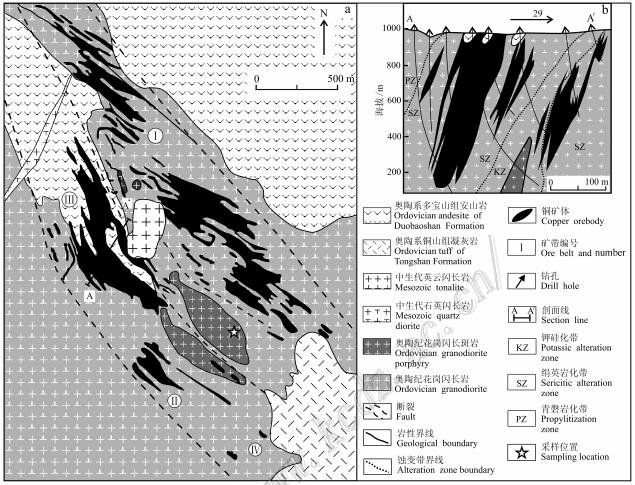
|
图 2多宝山斑岩Cu_Mo矿床地质简图(a)及Ⅲ号矿带剖面图(b, 据杜琦等,1988;赵 一鸣等,1997b修改) Fig. 2Simplified geological map (a) and schematic geological cross section of ore belt Ⅲ (b) of the Duobaoshan porphyry Cu_Mo deposit (modified after Du et al., 1988; Zhao et al., 1997b) |
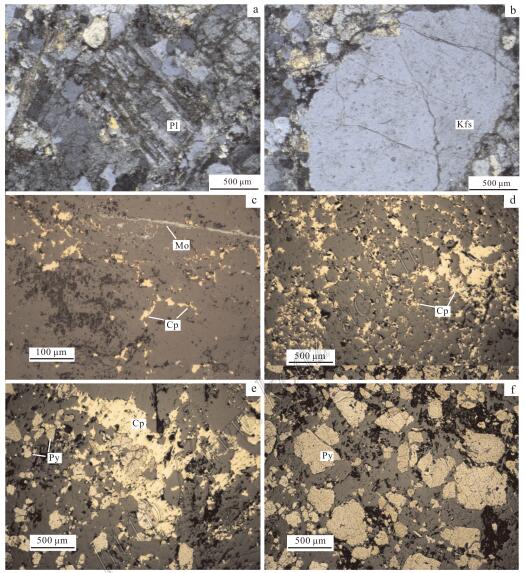
|
图 3多宝山矿床典型岩/矿石显微照片 a. 花岗闪长斑岩; b. 花岗闪长斑岩; c. 他形粒状黄铜矿、薄膜状辉钼矿; d. 他形粒 状黄铜矿; e. 他形粒状黄铜矿交代早期黄铁矿; f. 半自形_他形粒状黄铁矿 Kfs—钾长石; Pl—斜长石; Cp—黄铜矿; Mo—辉钼矿; Py—黄铁矿 Fig. 3Microscope photograp HS of rock/ores from the Duobaoshan deposit a. Granodiorite porphyry; b. Granodiorite porphyry; c. Anhedral granular chalcop yrite and film molybdenite; d. Anhedral granular chalcopyrite; e. Anhedral gra nular chalcopyrite replacing pyrite; f. Subhedral_anhedral granular pyrite Kfs—K_feldspar; Pl—Plagioclase; Cp—Chalcopyrite; Mo—Molybdenite; Py—Pyrite |
3样品特征及测试方法
3.1样品特征
花岗闪长斑岩样品采自Ⅲ号矿带采坑东南500 m的地表探槽中(图2a)。采样时,尽量选择 新鲜未蚀变的岩石,但部分样品仍可见轻微的硅化和钾化蚀变。岩石呈块状构造,斑状结构 。斑晶含量25%~40%,主要斑晶矿物有斜长石(40%~65%)、石英(15%~20%)、钾长石( 10% ~15%)及黑云母(5%~10%),大小在0.5~4 mm左右。其中,斜长石呈半自形板状,聚片 双晶 发育,可见绢云母化;石英呈他形粒状,波状消光;钾长石为半自形板状或他形粒状,具条 纹结构,表面发育高岭石化。基质含量60%~75%,呈显微花岗结构,由细粒状斜长石、钾长 石及石英等组成,粒径一般<0.2 mm。副矿物为锆石、磷灰石和榍石等。
3.2测试方法
将采集的花岗闪长斑岩样品破碎,按重力和磁选方法分选,最后在双目镜下根据锆石颜色、 自形程度、形态等特征初步分类,挑选出具有代表性的锆石。将分选好的锆石用环氧树脂制 靶、打磨和抛光。锆石的阴极发光(CL)图像在北京锆年领航科技有限公司完成,仪器为日 本JEOL公司生产的JSM6510型扫描电子显微镜。LA_MC_ICP_MS锆石U_Pb定年测试工作在国土 资源部成矿作用与资源评价重点实验室完成,锆石定年分析所用仪器为Finnigan Neptune型 MC_ICP_MS及与之配套的Newwave UP 213激光剥蚀系统。激光剥蚀所用束斑直径为25 μm, 频率为10 Hz,能量密度约为2.5 J/cm2,以He为载气。信号较小的207Pb 、206Pb、204Pb(+204Hg)、202 Hg用离子计数器(multi_ion_counters)接收,208Pb、232 Th、238U信号用法拉第杯接收,实现了所有目标同位素信号的同时接收, 并 且不同质量数的峰基本上都是平坦的,进而可以获得高精度的数据,均匀锆石颗粒 207Pb/206Pb、206Pb/238U、207 Pb/235U的测试精度均为2%左右,对锆石标准的定年精度和准确度在1%左右。 测试过程中在每测定5~7个样品前后重复测定2个锆石GJ1对样品进行校正,并测量1个锆石P lesovice,观察仪器的状态以保证测试的精确度。详细实验测试过程见侯可军等(2009)。 7件花岗闪长斑岩样品的主量、微量元素测试工作在中国科学院地球化学研究所矿床地球化 学国家重点实验室完成,其中,主量元素采用Axios PW4400型X射线荧光光谱仪(XRF)分析 ,分析误差小于5%,微量、稀土元素分析采用Finnigan MAT公司ELEMENT型ICP_MS分析,分 析精度优于10%。
锆石完成U_Pb定年后,在原位用LA_MC_ICP_MS进行Lu_Hf同位素分析,测试工作在国土资源 部成矿作用与资源评价重点实验室完成。实验过程中采用He作为剥蚀物质载气,剥蚀直径为 55 μm,测定时使用锆石国际标样GJ1作为参考物质,分析点与U_Pb定年分析点为同一位置 。分析过程中锆石标准GJ1的176Hf/177Hf测试加权平均值为 0.282 008±0.000 025(2σ,n=26)。相关仪器运行条件及详细分析流程 见侯可军(2007)。
4测试结果
4.1锆石U_Pb定年
花岗闪长斑岩中锆石大多呈长柱状,少量为短柱状,粒径集中在100~150 μm,无色透明或 黄褐色,显示清楚的生长韵律环带(图4)。11颗锆石的Th/U比值介于0.5~1.2,大于0. 1;w(Th)介于24.8×10-6~218.8×10-6,平均值92.3×10 -6;w(U)介于50.1×10-6~205.6×10-6,平均值118.8×10 -6(表1),据此认为锆石为岩浆成因。11颗锆石给出了(474.9± 1.8)Ma的加权平均年龄(MSWD=1.8)(图5),代表了花岗闪长斑岩体的结晶年龄,与多宝山矿床铜钼矿化年龄相吻合。

|
图 4多宝山矿床花岗闪长斑岩锆石代表性CL图像 Fig. 4Representative cathodoluminescence (CL) images of zircons from the grano diorite porphyry with analytical numbers of the Duobaoshan deposit |
Table 1LA_ICP_MS zircon U_Pb data of the granodiorite porphyry from the Duobao shan deposit

|
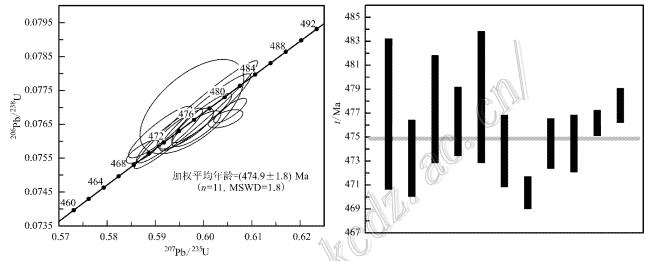
|
图 5多宝山矿床花岗闪长斑岩锆石U_Pb年龄图解 Fig. 5Zircon U_Pb ages of the granodiorite porphyry from the Duobaoshan deposi t |
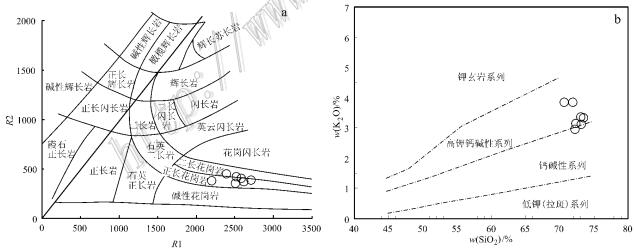
|
图 6多宝山矿床花岗闪长斑岩R1_R2分类图解(a,底图据De la Roche et al., 1980)和SiO2_K2O图解(b,底图据Peccerillo et al., 1976) Fig. 6R1_R2 diagram (a, base map after De la Roche et al., 1980) and S iO2_K 2O diagram (b, base map after Peccerillo et al., 1976) of the granodiorite p orphyry from the Duobaoshan deposit |
4.2岩石主量、微量及稀土元素
花岗闪长斑岩的w(SiO2)和w(Al2O3)分别为70.73%~73.45%、13.2 0%~14.99%。玾w(K2O)、w(Na2O)及w(K2O+Na2O)分 别为2 .99%~3.88%、3.86%~4.38%及7.22%~8.26%。K2O/Na2O比值介于0.70~0.93 。w(MgO)、w(CaO)和w(FeOT)分别为0.35%~0.53 %、0 .56%~1.33%及1.87%~2.93%。铝指数A/CNK为1.01~1.26 (表2)。在花岗岩类R1_R2分类图解(图6a)中,投影点主要落入正长花岗岩和二长花岗岩区域。在SiO2_K2O图解(图6b)中,投影点主要 落入高钾钙碱性系列区域。

|
表 2多宝山矿床花岗闪长斑岩主量元素、微量及稀土元素分析结果 Table 2Analyzed data of major elements, trace and rare earth elements of the g ranodiorite porphyry from the Duobaoshan deposit |
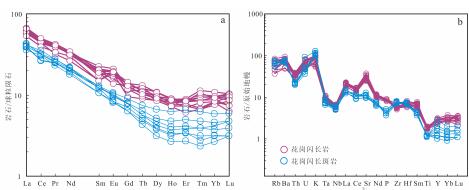
|
图 7多宝山矿床稀土元素配分曲线和微量元素蛛网图(标准化数值分别采用Boynton, 198 4; Taylor et al., 1985; 花岗闪长岩数据引自Wu et al.,2015) Fig. 7Chondrite_normalized REE patterns and primitive mantle normalized trace elements spider diagram of the Duobaoshan deposit (normalization values after Boynton, 1984; Taylor et al., 1985;Data of granodiorite after Wu et al.,2015 ) |
4.3锆石Lu_Hf同位素
11颗锆石的176Yb/177Hf和176Lu/177Hf比 值 分别为0.013 99~0.035 823、0.000 554~0.001 327。1 76Lu/177Hf比值小于0.002,表明这些锆石在形成后仅具有较少的放射成因 Hf 积累,因此,可以用初始176Hf/177Hf比值代表锆石形成时的 176Hf/177Hf比值(吴福元等,2007)。锆石的εHf(t)值为10. 3~14.6,平均值为13.4。fLu/Hf值介于-0.98~-0.96,明显小 于镁铁质地壳的fLu/Hf(-0.34,Amelin et al., 2000)和硅铝质地壳的f Lu/Hf(-0.72,Vervoort et al., 1996),故二阶段模式年龄更能反映其源区物质 从亏损地幔被抽取的时间 (第五春荣等,2007),锆石Hf同位素二阶段模式年龄tDM2为523~799 Ma,平 均值为601 Ma(表3)。
5讨论
5.1构造背景
古亚洲洋产生于罗迪尼亚大陆裂解时期,长期存在于东欧_西伯利亚陆块与塔里木_华北陆块 之间的一个东西向古大洋,现今记录在西伯利亚板块南缘、东欧地台东南缘以及中亚造山带 内(李三忠等,2016)。古亚洲洋大约在1000 Ma前开始张开,大规模扩张在700~600 Ma, 在经历过若干微板块之间、 微板块与南北大陆之间的碰撞之后,直至二叠纪最终闭合(徐备 等,1997;Wu et al., 1998;洪大卫等,2003;孙德友等,2004;Li,2006;李锦轶等,2 007;Cao et al., 2013;Chen et al., 2016)。西伯利亚板块南缘近东西向展布的大型高 压变质带中蓝片岩代表的洋盆于650~520 Ma开始俯冲(张兴洲等,1992;徐公愉,1993; 李 三忠等2016)。石玉若等(2014)研究表明,内蒙古中部地区(温都尔庙_西拉木伦、锡林 浩特地区)不仅存在早奥陶世蛇绿岩,而且存在该时期的俯冲消减事件,反映奥陶纪古亚洲 洋洋盆在这一区域仍较活跃,存在双向俯冲作用。Ge等(2005; 2007) 在大兴安岭北部发现了早古生代辉长岩 (LA_ICP_MS锆石U_Pb年龄为480~494 Ma)和花岗闪长岩(SHRIMP锆石U_ Pb年龄为(485±8)Ma),认为古生代区域上发生了从俯冲消减到碰撞后阶段的 演化过程, 而施光海等(2003)、Pei等(2007)和Miao等(2007)在一些深变质杂岩中也发现了早古 生代岩浆锆石。佘宏全等(2012)对大兴安岭中北段岩浆岩的锆石U_Pb年龄进行了统计,认 为该地区在古生代期间经历了古陆块间的俯冲、拉张、拼贴碰撞的构造演化历史。综上所述 ,晚寒武世—奥陶纪期间,古亚洲洋在中亚造山带东段地区存在强烈的与俯冲作用有关的岩 浆活动。
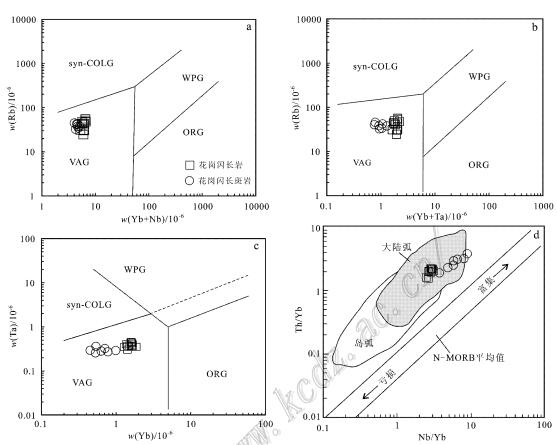
|
图 8多宝山矿床构造环境判别图解(花岗闪长岩数据引自Wu et al.,2015) a. (Yb+Nb)_Rb关系图(底图据Pearce et al., 1984); b. (Yb+Ta)_Rb关系图(底图据Pe arce et al., 1984); c. Yb_Ta关系图 (底图据Pearce et al., 1984); d. Nb/Yb_T h/Yb 关系图(底图据Pearce et al., 1995) VAG—火山弧花岗岩;syn_COLG—同碰撞花岗岩;ORG—洋脊花岗岩; WPG—板内花岗岩 Fig. 8Tectonic discrimination diagrams of the Duobaoshan deposit (Data of gran odiorite after Wu et al., 2015) a. (Yb+Nb)_Rb diagram (after Pearce et al., 1984); b. (Yb+Ta)_Rb diagram (after Pear ce et al., 1984); c. Yb_Ta diagram (after Pearce et al., 1984); d. Nb/Yb_Th/Yb diagram (after Pearce and Peate, 1995) VAG—Volcanic arc granites; syn_COLG—Syn_collisional granites; ORG—Oceanic rid ge granites; WPG—Within plate granites |
5.2岩石成因及源区
埃达克岩是Defant等(1990)研究阿留申群岛新生代俯冲洋壳熔融产生的火山岩时提出来的 术语,用于概括具有特定地球化学性质的一套中酸性火山岩和侵入岩组合,包括安山岩、英 安岩、安粗岩、石英闪长岩、花岗闪长岩、石英二长岩、英云闪长岩和斜长花岗岩等,其地 球化学标志是w(SiO2)≥56%,w(Al2O3)≥15%,w(MgO)<3% ,w(Na2O)/w(K2O)>2.4,w(Y)和重稀土元素(HREE)含 量低(w(Yb)≤ 1.9×10-6,w(Y)≤18×10-6),高w(Sr)(多大于400 ×10-6),一般具有正铕异常(少数具有极弱负铕异常)。然而,具有上述地球化 学特征、与俯冲洋壳熔融无关的岩石通常被称为“埃达克质(adakitic)岩"(Castillo,2 006;2012)。多宝山花岗闪长岩体具有高w(SiO2)(62.54%~65.24%)、w (Al2O3)(16.22%~17.43%)和w(Sr)(542×10-6~807×10 -6)、低w(Yb)(1.29×10-6~1.86×10-6)和w(Y )(10.6×10-6~14.4×10-6)含量、正铕异常或弱负铕异常,显示 出埃达克质岩石 的特征(Wu et al., 2015)。Wu等(2015)对多宝山花岗闪长岩体开展了详细的主微量元 素及Sr_Nd_Hf同位素地球化学研究,认为 花岗闪长岩体形成于增厚下地壳的部分熔融过程, 来源于亏损地幔新增生的年轻地壳物质。一般认为 由地幔熔融产生高SiO2含量的花岗质岩浆是十分 困难和有限的,具有正εHf(t)值的花岗质岩石一般来自亏损地幔或从 亏 损地幔中新 增生的年轻地壳物质的部分熔融(孙德有等,2005;隋振民等,2007)。多宝山花岗闪长斑 岩体具有较高的Hf同位素组成(εHf(t)=10.3~14.6),锆石Hf同位素二 阶段模式年龄tDM2为523~799 Ma(平均值601 Ma),揭示其源区可能为新元古 代期间从亏损地幔新增生的年轻 下地壳(图9)。多宝山花岗闪长斑岩体侵位于大规模分布的花岗闪长岩体内,虽然不显示 埃达克质岩石的地球化学特征,但其与花岗闪长岩体侵位时间 接近并拥有相似的微量、稀土 元素配分模式和Hf同位素组成(图7,图9),而且它们的主量元素随着SiO2含量的递增表 现出明显的线性变化趋势(图10),因此,笔者认为这两期岩体可能是同源岩浆不 同演化阶段的产物。
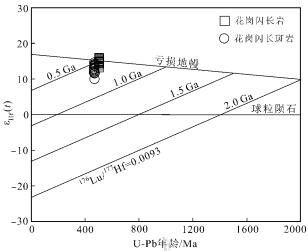
|
图 9多宝山矿床花岗闪长斑岩锆石εHf(t)与 U_Pb年龄图解 花岗闪长岩数据引自Wu et al.,2015 Fig. 9Plot of εHf(t) versus U_Pb ages for the granodiorite porphy ry from the Duobaoshan deposit Data of granodiorite after Wu et al.,2015 |
从这种地幔产生的 基性熔体底侵于加厚下地壳底部,必然使下地壳越来越富水并发生部分熔融作用,早阶段分 异结晶出多宝山埃达克质花岗闪长岩体,晚阶段演化出多宝山花岗闪长斑岩体。这种在加厚 陆壳条件下新生的水化基性下地壳的部分熔融机制,与秘鲁西北部高安第斯带著名的 Cordillera Blanca花岗质岩基岩石成因相似(Atherton et al., 1993;Petford et al., 1992; 1996a; 1996b; 2001;刘红涛等,2004),同时,与Kay及其同事对智利中部新生代消减区 埃达克岩浆的成因解释十分接近(Kay et al., 2001;2002)。
6结论
多宝山矿床花岗闪长斑岩的LA_ICP_MS锆石U_Pb年龄为(474.9±1.8) Ma,形成于早奥 陶世。岩石具有高SiO2(70.73%~73.45%)和Al2O3 (13.20%~14.99%)含量,轻 稀土元素富集,重稀土元素亏损,具有较高的La/Nb(2.09~2.75)、Ba/Nb(113.32~1 45.66)、Ba/La(47.52~65.73)、Ba/Th (256.68~318.18)、Zr/Nb(17.51~23.75)比值和低 的Th/Yb(1.85~3.91)比值、低的TiO2(<1%)含量,显示出俯冲环境 下岩浆岩的地球化学特征。花岗闪长斑岩形 成于大陆边缘弧环境,来源于加厚陆 壳条件下亏损地幔新增生的年轻地壳物质的部分熔 融。

|
图 10多宝山矿床SiO2_氧化物变异图(花岗闪长岩数据引自Wu et al.,2015) Fig. 10Variation diagrams of SiO2_oxides of the Duobaoshan deposit (Data of granodiorite after Wu et al.,2015) |
参考文献
Amelin Y, Lee D C and Halliday A N. 2000. Early_Middle Archaean crustal evolution deduced from Lu_Hf isotopic studies of single zircon grains[J]. Geoc himica et Cosmochimica Acta, 64: 4205_4225.
Atherton M P and Petford N. 1993. Generation of sodium rich magmas from newly un der plated basaltic crust[J]. Nature, 362, 144_146.
Blichert_Toft J and Albarède F. 1997. The Lu_Hf geochemistry of chondrites and the evolution of the mantle_crust system[J]. Earth and Planetary Science Lette rs, 148: 243_258.
Boynton W V. 1984. Cosmochemistry of the rare earth elements: Meteorite studies [J]. Geochemistry, 2: 63_114.
Cao H H, Xu W L, Pei F P, Wang Z W, Wang F and Wang Z J. 2013. Zircon U_Pb geoch ronology and petrogenesis of the Late Paleozoic_Early Mesozoic intrusive rocks i n the eastern segment of the northern margin of the North China Block[J]. Lith os, 170_171: 91_207.
Castillo P R. 2006. An overview of adakite petrogenesis[J]. Chinese Science Bu lletin, 51: 257_268.
Castillo P R. 2012. Adakite petrogenesis[J]. Lithos, 134: 304_316.
Che H W, Zhou Z H, Ma X H, Ouyang H G and Liu J. 2015. Geochemical characteristi cs, zircons U_Pb ages and Hf isotopic composition of the dacite porphyry from Zh engguang Au deposit in northern Great Xingan Range[J]. Acta Geologica Sinica, 89(8): 1417_1436 (in Chinese with EnglishAbstract).
Chen Y J and Li N. 2009. Nature of ore_fluids of intracontinental intrusion_rela ted hypothermal deposits and its difference from those in island arcs[J]. Acta Petrologica Sinica, 25(10): 2477_2508 (in Chinese with EnglishAbstract).
Chen Y J, Zhang C, Wang P, Pirajno F and Li N. 2016. The Mo deposits of northeas t China: A powerful indicator of tectonic settings and associated evolutionary t rends[J]. Ore Geology Reviews, http://dx.doi.org/10.1016/j.oregeorev.2016.04.0 17.
Cui G, Wang J Y and Zhang J X. 2008. SHRIMP U_Pb dating of zircon from Duobaosha n granodiorite in Heilongjiang and its geological significance[J]. Global Geol ogy, 27(4): 387_394 (in Chinese with EnglishAbstract).
De la Roche H, Leterrier J, Granclaude P and Marchal M. 1980. A classiflcation o f volcanic and plutonic rocks using R1_R2 diagram and major_element analy ses: Its relationships with current nomenclature[J]. Chemical Geology, 29: 183_210.
Defant M J and Drummond M S. 1990. Derivation of some modern arc magmas by melti ng of young subducted lithosphere[J]. Nature, 347(18): 662_665.
Diwu C R, Sun Y, Lin C L, Liu X M and Wang H L. 2007. Zircon U_Pb ages and Hf is otopes and their geological significance of Yiyang TTG gneisses from Henan Provi nce, China[J]. Acta Petrologica Sinica, 23(2): 253_262 (in Chinese with Englis hAbstract).
Du Q, Zhao Y M, Lu B G, Ma D Y, Li P L, Lü J K, Li W S, Ao L Z and Cui G. 1988. The Duobaoshan porphyry copper deposit[M]. Beijing: Geological Publishing Hou se. 334p (in Chinese with EnglishAbstract).
Ge W C, Wu F Y, Zhou C Y and Abdel Rahman A A. 2005. Emplacement age of the Tahe granite and its constraints on the tectonic nature of the Ergun block in the no rthern part of the Great Xingan Range[J]. Chinese Science Bulletin, 50: 2097_ 2105.
Ge W C, Wu F Y, Zhou C Y and Zhang J H. 2007. Porphyry Cu_Mo deposits in the eas tern Xingan_Mongolian Orogenic Belt: Mineralization ages and their geodynam ic implications[J]. Chinese Science Bulletin, 52 (24): 3416_3427(in Chinese w ith EnglishAbstract).
Green T H and Pearson N J. 1986. Rare_earth element partitioning between sphene and coexisting silicate liquid at high pressure and temperature[J]. Chemical G eology, 55(1_2): 105_119.
Griffin W L, Pearson N J, Belousova E, Jackson S E, Van Achterbergh E, OReilly S Y and Shee S R. 2000. The Hf isotope composition of cratonic mantle: LA_MC_ICP MS analysis of zircon megacrysts in kimberlites[J]. Geochimica et Cosmochimica Acta, 64: 133_147.
Han Z X, Xu Y Q and Zheng Q D. 2004. Metallogenetic series and evolution of sign ificant metal and nonmetal mineral resources in Heilongjiang Province[M]. Harb in : Heilongjiang Peoples Publishing House. 241p (in Chinese with EnglishAbstract).
Hawkesworth C J, Hergt J M, Ellam R M and McDermott F. 1991. Element fluxes asso ciated with subduction related magmatism[J]. Philosophical Transactions of the Royal Society of London, 335: 393_405.
Hong D W, Wang S G, Xie X L, Zhang J S and Wang T. 2003. Correlation between con tinental crustal growth and the supercontinental cycle: Evidence form the granit es with positive εNd in the Central Asian Orogenic Belt[J]. Acta Ge ologica Sinica, 77(2): 203_209 (in Chinese with EnglishAbstract).
Hou K J, Li Y H, Zou T R, Qu X M, Shi Y R and Xie G Q. 2007. LA_MC_ICP_MS techni que for Hf isotope microanalysis of zircon and its geological applications[J]. Acta Petrologica Sinica, 23(10): 2595_2604 (in Chinese with EnglishAbstract).
Hou K J, Li Y H and Tian Y R. 2009. In situ U_Pb dating using laser ablation_mul ti ion counting_ICP_MS[J]. Mineral Deposits, 28(4): 481_492 (in Chinese with E nglishAbstract).
Kay S M and Mpodozis C. 2001. Central Andean ore deposits linked to evolving sha llow subduction systems and thickening crust[J]. GSA Today, 11(3): 4_9.
Kay S M and Mpodozis C. 2002. Magmatism as probe to the Neogene shallowing of th e Nazca plate beneath the modern Chilean flatslab[J]. Journal of South Ame rican Earth Sciences, 15: 39_57.
Kelemen P B, Johnson K T M, Kinzler R J and Irving A J. 1990. High_field_strengt h element depletions in arc basalts due to mantle_magma interaction[J]. Nature , 345: 521_524.
Li J Y. 2006. Permian geodynamic setting of northeast China and adjacent regions : Closure of the paleo_Asian Ocean and subduction of the paleo_Pacific plate[J ]. Journal of Asian Earth Sciences, 26(3_4): 207_224.
Li J Y, Gao L M, Sun G H, Li Y P and Wang Y B. 2007. Shuangjingzi middle Triassi c syn_collisional crust_derived granite in the east Inner Mongolia and its const raint on the timing of collision between Siberian and Sino_Korean paleo_plates[ J]. Acta Petrologica Sinica, 23(3): 565_582(in Chinese with EnglishAbstract).
Li S Z, Yang C, Zhao S J, Li X Y, Suo Y H, Guo L L, Yu S, Dai L M, Li S J and Mo u D L. 2016. Global Early Paleozoic Orogens (II): Subduction_accretionary type O rogeny[J]. Journal of Jilin University (Earth Science Edition), 46(4): 1_39 (i n Chinese with EnglishAbstract).
Li Z T, Wang X J, Wang H B and Wu G. 2008. Geology of the Sankuanggou gold_beari ng iron_copper deposit in Nenjiang County, Heilongjiang Province[J]. Geology a nd Resources, 17 (3): 170_174 (in Chinese with EnglishAbstract).
Liu C, Mu Z G, Liu R X and Huang B L. 1995. 40Ar/39Ar laser microprobe dating on hydrothermal minerals form Duobaoshan porphyry copper mining district, Heilongj iang Province, China[J]. Scientia Geologica Sinica, 30(4): 329_337 (in Chinese with EnglishAbstract).
Liu H T, Zhang Q, Liu J M, Ye J, Zeng Q D and Yu C M. 2004. Adakite versus porph yry copper and epithermal gold deposits: A possible metallogenetic specializatio n of magmatism required in_deep assessment[J]. Acta Petrologica Sinica, 20(2): 205_218(in Chinese with EnglishAbstract).
Liu J, Wu G, Zhong W and Zhu M T. 2009. Fluid inclusions study of the Sankuanggo u skarn Fe_Cu deposit, Heilongjiang Province, China[J]. Acta Petrologica Sinic a, 25(10): 2631_2641(in Chinese with EnglishAbstract).
Liu J, Wu G, Zhong W and Zhu M T. 2010. Fluid inclusion study of the Duobaoshan porphyry Cu (Mo) deposit, Heilongjiang Province, China[J]. Acta Petrologica Si nica, 26(5): 1450_1464 (in Chinese with EnglishAbstract).
Liu J, Wu G, Li Y, Zhu M T and Zhong W. 2012. Re_Os sulfide (chalcopyrite, pyrit e and molybdenite) systematics and fluid inclusion study of the Duobaoshan porph yry Cu(Mo) deposit, Heilongjiang Province, China[J]. Journal of Asian Earth Sc iences, 49: 300_312.
Liu J, Li Y, Zhou Z H, OuYang H G. 2017. The Ordovician igneous rocks with high Sr/Y at the Tongshan porphyry copper deposit, satellite of the Duobaoshan deposi t, and their metallogenic role[J]. Ore Geology Reviews, 86: 600_614.
Miao L C, Liu D Y, Zhang F Q, Fan W M, Shi Y R and Xie H Q. 2007. Zircon SHRIMP U_Pb ages of the “Xinghuadukou Group" in Hanjiayuanzi and Xinlin areas and the “Zhalantun Group" in Inner Mongolia, Da Hinggan Mountains[J]. Chinese Science Bulletin, 52(8): 1112_1124.
Pearce J A, Harris N B W and Tindle A G. 1984. Trace element discrimination diag rams for the tectonic interpretation of granitic rocks[J]. Journal of Petr ology, 25: 956_983.
Pearce J A and Peate D W. 1995. Tectonic implications of the composition of volc anic arc magmas[J]. Annual Review of Earth and Planetary Sciences, 23: 251_285 .
Pearce J A, Kempton P D, Nowell G M and Noble S R. 1999. Hf_Nd element and isoto pe perspective on the nature and provenance of mantle and subduction components in western Pacific arc_basin systems[J]. Journal of Petrology, 40: 1579_1611.
Peccerillo R and Taylor S R. 1976. Geochemistry of Eocene calc_alkaline volcanic rocks from the Kastamonu area, northern Turkey[J]. Contributions to Mineralog y and Petrology, 50: 63_81.
Pei F P, Xu W L, Yang D B, Zhao Q G, Liu X M and Hu Z C. 2007. Zircon U_Pb geoch ronology of basement metamorphic rocks in the Songliao Basin[J]. Chinese Scien ce Bulletin, 52 (7): 942_948.
Petford N and Atherton M P. 1992. Granitoid emplacement and deformation along a major crustal lineament: The Cordillera Blanca, Peru[J]. Tectonophysics, 2 05: 171_185.
Petford N and Atherton M P. 1996a. Na_rich partial melts from newly underplated basaltic crust: The Cordillera Blanca batholith. Peru[J]. Journal of Petro logy, 37: 1491_1521.
Petford N, Atherton M P and Halliday A N. 1996b. Rapid magma production rates, u nderplating and remelting in the Andes: Isotopic evidence from northern_cent ral Peru[J]. Journal of South American Earth Sciences, 9: 69_78.
Petford N and Gallagher K. 2001. Partial melting of mafic (amphibolitic) lower c rust by periodic influx of basaltic magma[J]. Earth and Planetary Science Lett ers, 193: 483_499.
She H Q, Li J W, Xiang A P, Guan J D, Yang Y C, Zhang D Q, Tan G and Zhang B. 20 12. U_Pb ages of the zircons from primary rocks in middle_northern Daxinganling and its implications to geotectonic evolution[J]. Acta Petrologica Sinica, 28( 2): 571_594 (in Chinese with EnglishAbstract).
Shi G H, Liu D Y, Zhang F Q, Jian P, Miao L C, Shi Y R and Tao H. 2003. Zircon S HRIMP U_Pb geochronology and significance of the Xilinhot metamorphic complex, I nner Mongolia, China[J]. Chinese Science Bulletin, 48(4): 2187_2192 (in Chines e).
Shi Y R, Liu C, Deng J F and Jian P. 2014. Geochronological frame of granitoids from Central Inner Mongolia and its tectonomagmatic evolution[J]. Acta Petrolo gica Sinica, 30(11): 3155_3171 (in Chinese with EnglishAbstract).
Soderlund U, Patchett P J, Vervoort J D and Isachsen C E. 2004. The 176Lu decay constant determined by Lu_Hf and U_Pb isotope systemat ics of Precamb rian mafic i ntrusions[J]. Earth and Planetary Science Letters, 219: 311_324.
Stern R J. 2002. Subduction zones[J]. Reviews of Geophysics, 40: 1_38.
Sui Z M, Ge W C, Wu F Y, Zhang J H, Xu X C and Cheng R Y. 2007. Zircon U_Pb ages , geochemistry and its petrogenesis of Jurassic granites in northeastern part of t he Da Hinggan mountains[J]. Acta Petrologica Sinica, 23(2): 461_480 (in Ch inese with EnglishAbstract).
Sun D Y, Wu F Y and Gao S. 2004. LA_ICP_MS zircon U_Pb age of the Qingshui pluto n in the east Xiaohinggan mountains[J]. Acta Geoscientica Sinica, 25(2): 213_ 218 (in Chinese with EnglishAbstract).
Sun D Y, Wu F Y, Gao S and Lu X P. 2005. Confirmation of two episodes of A_type granite emplacement during Late Triassic and Early Jurassic in the Central Jilin Province, and their constraints on the structural pattern of eastern Jilin_Heil ongjiang area, China[J]. Earth Science Frontiers, 12(2): 263_275 (in Chinese w ith EnglishAbstract).
Tan C Y, Wang G H and Li Y S. 2010. New progress and significance on the mineral exploration in Duobaoshan mineralization area, Heilongjiang, China[J]. Geolog ical Bulletin of China, 29(2_3): 436_445 (in Chinese with EnglishAbstract).
Taylor S R and McLennan S M. 1985. The continental crust: Its composition and ev olution[M]. Oxford: Blackwell Scientific Publications. 54_374.
Vervoort J D, Pachelt P J, Gehrels G E and Nutman A P. 1996. Constraints on earl y Earth differentiation from hafnium and neodymium isotopes[J]. Nature, 379: 6 24_627.
Wang X C, Wang X L, Wang L, Liu J Y, Xia B, Deng J and Xu X M. 2007. Metallogeny and reformation of the Duobaoshan superlarge porphyry copper deposit in Heilong jiang[J]. Chinese Journal of Geology, 42 (1): 124_133 (in Chinese with Eng lishAbstract).
Woodhead J, Eggins S and Gamble J. 1993. High field strength and transition elem ent systematics in island and back_arc basin basalts: Evidence for multi_phase e xtraction and a depleted mantle wedge[J]. Earth and Planetary Science Lett ers, 114: 491_504.
Wu F Y, Li X H, Zheng Y F and Gao S. 2007. Lu_Hf isotopic systematics and th eir applications in petrology[J]. Acta Petrologica Sinica, 23(2): 185_220 (in Chin ese with EnglishAbstract).
Wu F Y, Sun D Y, Ge W C, Zhang Y B, Grant M L, Wilde S A and Jahn B M. 2011. Geo chronology of the Phanerozoic granitoids in northeastern China[J]. Journal of Asian Earth Sciences, 41(1): 1_30.
Wu G, Liu J, Zhong W, Zhu M T, Mei M and Wan Q. 2009. Fluid inclusion study of t he Tongshan porphyry copper deposit, Heilongjiang Province, China[J]. Acta Pet rologica Sinica, 25(11): 2995_3006 (in Chinese with EnglishAbstract).
Wu G, Chen YC, Sun FY, Liu J, Wang G R and Xu B. 2015. Geochronology, geochemist r y, and Sr_Nd_Hf isotopes of the Early Paleozoic igneous rocks in the Duobaoshan area, NE China, and their geological significance[J]. Journal of Asian Earth S ciences, 97: 229_250.
Wu T R, He G Q and Zhang C. 1998. On Palazoic tectonics in the Alxa region, Inne r Mongolia, China[J]. Acta Geologica Sinica, 72(3): 256_263.
Xiang A P, Yang Y C, Li G T, She H Q, Guan J D, Li J W and Guo Z J. 2012. Diagen etic and metallogenic ages of Duobaoshan porphyry Cu_Mo deposit in Heilongjiang Province[J]. Mineral Deposits, 31(6): 1237_1248 (in Chinese with English abstr act).
Xu B and Chen B. 1997. The structure and evolution of a Middle Paleozoic orogeni c belt between the North China and Siberian Blocks, northern Inner Mongolia, Chi na[J]. Science in China (Series D), 27(3): 227_232 (in Chinese).
Xu G Y. 1993. The tectonic evolution of Paleo_Asiatic ocean in the northeast Asi a Area[J]. Jilin Geology, 3: 1_8 (in Chinese with EnglishAbstract).
Zeng Q D, Liu J M, Chu S X, Wang Y B, Sun Y, Duan X X, Zhou L L and Qu W J. 2014 . Re_Os and U_Pb geochronology of the Duobaoshan porphyry Cu_Mo_(Au) deposit, no rtheast China, and its geological significance[J]. Journal of Asian Earth Scie nces, 79: 895_909.
Zhang X Z and Sklyarov E V. 1992. The Tectonic significance of the Blueschist Be lt in the northeast China and its adjacent regions[J]. Journal of Changchun Co llege of Geology, 99: 106 (in Chinese with EnglishAbstract).
Zhao Y M, Bi C S, Zou X Q, Sun Y L, Du A D and Zhao Y M. 1997a. The Re_Os isotop ic age of molybdenite from Duobaoshan and Tongshan porphyry copper (molybdenum) deposits[J]. Acta Geoscientia Sinica, 18 (1): 61_67 (in Chinese with English a bstract).
Zhao Y M and Zhang D Q. 1997b. Metallogeny and prospective evaluations of copper _polymetallic deposits in the great Hinggan range and its adjacent regions[M]. Beijing: Seismological Press. 318p (in Chinese with EnglishAbstract).
Zhou M F, Lesher C M, Yang Z X, Li J W and Sun M. 2004. Geochemistry and petroge nesis of 270 Ma Ni_Cu_(PGE) sulfide_bearing mafic intrusions in the Huangshan di strict, eastern Xinjiang, northwest China: Implications for the tectonic evoluti on of the Central Asian orogenic belt[J]. Chemical Geology, 209: 233_257.
附中文参考文献
车合伟,周振华,马星华,欧阳荷根,刘军.2015.大兴安岭北段争光金矿英安斑 岩 地球化学特征、锆石U_Pb年龄及Hf同位素组成[J]. 地质学报,89(8):1417_1436 .
陈衍景,李诺.2009.大陆内部浆控高温热液矿床成矿流体性质及其与岛弧区同类矿床的差 异[J].岩石学报,25(10):2477_2508.
崔根,王金益,张景仙,崔革.2008.黑龙江多宝山花岗闪长岩的锆石SHRIMP U_Pb年龄及 其地质意义[J].世界地质,27(4):387_394.
第五春荣,孙勇,林慈銮,柳小明,王洪亮.2007.豫西宜阳地区TTG质片麻岩锆石U_Pb定 年和Hf同位素地质学[J].岩石学报,23(2):253_262.
杜琦,赵玉明,卢秉刚,马德友,李佩兰,律景凯,李文深,敖立志,崔革.1988.多宝山 斑岩铜矿床[M].北京:地质出版社. 1_334.
葛文春,吴福元,周长勇,张吉衡.2007.兴蒙造山带东段斑岩型Cu,Mo矿床成矿时代及其 地球动力学意义[J].科学通报,52(20):2407_2417.
韩振新,徐衍强,郑庆道.2004.黑龙江省重要金属和非金属矿产的成矿系列及其演化[M ].哈尔滨:黑龙江人民出版社. 1_241.
洪大卫,王式●,谢锡林,张季生,王涛.2003.从中亚正εNd值花岗岩看超大 陆演化和大陆地壳生长的关系[J].地质学报,77(2):203_209.
侯可军,李延河,邹天人,曲晓明,石玉若,谢桂青.2007.LA_MC_ICP_MS锆石Hf同位素的 分析方法及地质应用[J].岩石学报,23(10):2595_2604.
侯可军,李延河,田有荣.2009.LA_MC_ICP_MS锆石微区原位U_Pb定年技术[J].矿床地 质,28(4):481_492.
李锦轶,高立明,孙桂华,李亚萍,王彦斌.2007.内蒙古东部双井子中三叠世同碰撞壳源 花岗岩的确定及其对西伯利亚与中朝古板块碰撞时限的约束[J].岩石学报,23(3):56 5_582.
李三忠,杨朝,赵淑娟,李玺瑶,索艳慧,郭玲莉,余珊,戴黎明,李少俊,牟墩玲.2016 .全球早古生代造山带(Ⅱ):俯冲_增生型造山[J]. 吉林大学学报(地球科学版 ),46(4):1_39.
李之彤,王希今,王宏博,武广.2008.黑龙江省嫩江县三矿沟含金铁铜矿床地质特征[J ].地质与资源,17(3):170_174.
刘驰,穆治国,刘如曦,黄宝玲.1995.多宝山斑岩铜矿区水热蚀变矿物的激光显微探针 40Ar/39Ar定年[J].地质科学,30(4):329_337.
刘红涛,张旗,刘建明,叶杰,曾庆栋,于昌明.2004.埃达克岩与Cu_Au成矿作用:有待 深入研究的岩浆成矿关系[J].岩石学报,20(2):205_218.
刘军,武广,钟伟,朱明田.2009.黑龙江省三矿沟矽卡岩型铁铜矿床流体包裹体研究[J ].岩石学报,25(10):2631_2641.
刘军,武广,钟伟,朱明田.2010.黑龙江省多宝山斑岩型铜(钼)矿床成矿流体特征及演 化[J].岩石学报,26(5):1450_1464.
佘宏全,李进文,向安平,关继东,杨郧城,张德全,谭刚,张斌.2012.大兴安岭中北段 原岩锆石U_Pb测年及其与区域构造演化关系[J]. 岩石学报,28(2):571_594.
施光海,刘敦一,张福勤,简平,苗来成,石玉若,陶华.2003.中国内蒙古锡林郭勒杂岩 SHRIMP锆石U_Pb年代学及意义[J].科学通报,48(20):2187_2192.
石玉若,刘翠,邓晋福,简平.2014.内蒙古中部花岗质岩类年代学格架及该区构造岩浆演 化探讨[J].岩石学报,30(11):3155_3171.
隋振民,葛文春,吴福元,张吉衡,徐学纯,程瑞玉.2007.大兴安岭东北部侏罗纪花岗质 岩石的锆石U_Pb年龄、地球化学特征及成因[J]. 岩石学报,23(2):461_480.
孙德有,吴福元,高山.2004.小兴安岭东部清水岩体的锆石激光探针U_Pb年龄测定[J] .地球学报,25(2):213_218.
孙德有,吴福元,高山,路孝平.2005.吉林中部晚三叠世和早侏罗世两期铝质A型花岗岩 的厘定及对吉黑东部构造格局的制约[J].地学前缘,12(2):263_275.
谭成印,王根厚,李永胜.2010.黑龙江多宝山成矿区找矿新进展及其地质意义[J].地 质通报,29(2_3):436_445.
王喜臣,王训练,王琳,刘金英,夏斌,邓军,徐秀梅.2007.黑龙江多宝山超大型斑岩铜 矿的成矿作用和后期改造[J].地质科学,42(1):124_133.
吴福元,李献华,郑永飞,高山.2007.Lu_Hf同位素体系及其岩石学应用[J].岩石学报 ,23(2):185_220.
武广,刘军,钟伟,朱明田,糜梅,万秋.2009.黑龙江省铜山斑岩铜矿床流体包裹体研究 [J].岩石学报,25(11):2995_3006.
向安平,杨郧城,李贵涛,佘宏全,关继东,李进文,郭志军.2012.黑龙江多宝山斑岩Cu _Mo矿床成岩成矿时代研究[J].矿床地质,31(6):1237_1248.
徐备,陈斌.1997.内蒙古北部华北板块与西伯利亚板块之间中古生代造山带的结构及演化 [J].中国科学(D辑),27(3):227_232.
徐公愉.1993.东北亚地区古亚洲洋的构造演化特点[J].吉林地质,3:1_8.
张兴洲,Sklyarov E V.1992.中国东北及邻区蓝片岩带的构造意义[J]. 长春地质 学院学报,99:106.
赵一鸣,毕承思,邹晓秋,孙亚莉,杜安道,赵玉明.1997a.黑龙江多宝山、铜山大型斑 岩铜(钼)矿床中辉钼矿的铼_锇同位素年龄[J].地球学报,18(1):61_67.
赵一鸣,张德全.1997b.大兴安岭及其邻区铜多金属矿床成矿规律与远景评价[M].北京 :地震出版社.1_318.
Atherton M P and Petford N. 1993. Generation of sodium rich magmas from newly un der plated basaltic crust[J]. Nature, 362, 144_146.
Blichert_Toft J and Albarède F. 1997. The Lu_Hf geochemistry of chondrites and the evolution of the mantle_crust system[J]. Earth and Planetary Science Lette rs, 148: 243_258.
Boynton W V. 1984. Cosmochemistry of the rare earth elements: Meteorite studies [J]. Geochemistry, 2: 63_114.
Cao H H, Xu W L, Pei F P, Wang Z W, Wang F and Wang Z J. 2013. Zircon U_Pb geoch ronology and petrogenesis of the Late Paleozoic_Early Mesozoic intrusive rocks i n the eastern segment of the northern margin of the North China Block[J]. Lith os, 170_171: 91_207.
Castillo P R. 2006. An overview of adakite petrogenesis[J]. Chinese Science Bu lletin, 51: 257_268.
Castillo P R. 2012. Adakite petrogenesis[J]. Lithos, 134: 304_316.
Che H W, Zhou Z H, Ma X H, Ouyang H G and Liu J. 2015. Geochemical characteristi cs, zircons U_Pb ages and Hf isotopic composition of the dacite porphyry from Zh engguang Au deposit in northern Great Xingan Range[J]. Acta Geologica Sinica, 89(8): 1417_1436 (in Chinese with EnglishAbstract).
Chen Y J and Li N. 2009. Nature of ore_fluids of intracontinental intrusion_rela ted hypothermal deposits and its difference from those in island arcs[J]. Acta Petrologica Sinica, 25(10): 2477_2508 (in Chinese with EnglishAbstract).
Chen Y J, Zhang C, Wang P, Pirajno F and Li N. 2016. The Mo deposits of northeas t China: A powerful indicator of tectonic settings and associated evolutionary t rends[J]. Ore Geology Reviews, http://dx.doi.org/10.1016/j.oregeorev.2016.04.0 17.
Cui G, Wang J Y and Zhang J X. 2008. SHRIMP U_Pb dating of zircon from Duobaosha n granodiorite in Heilongjiang and its geological significance[J]. Global Geol ogy, 27(4): 387_394 (in Chinese with EnglishAbstract).
De la Roche H, Leterrier J, Granclaude P and Marchal M. 1980. A classiflcation o f volcanic and plutonic rocks using R1_R2 diagram and major_element analy ses: Its relationships with current nomenclature[J]. Chemical Geology, 29: 183_210.
Defant M J and Drummond M S. 1990. Derivation of some modern arc magmas by melti ng of young subducted lithosphere[J]. Nature, 347(18): 662_665.
Diwu C R, Sun Y, Lin C L, Liu X M and Wang H L. 2007. Zircon U_Pb ages and Hf is otopes and their geological significance of Yiyang TTG gneisses from Henan Provi nce, China[J]. Acta Petrologica Sinica, 23(2): 253_262 (in Chinese with Englis hAbstract).
Du Q, Zhao Y M, Lu B G, Ma D Y, Li P L, Lü J K, Li W S, Ao L Z and Cui G. 1988. The Duobaoshan porphyry copper deposit[M]. Beijing: Geological Publishing Hou se. 334p (in Chinese with EnglishAbstract).
Ge W C, Wu F Y, Zhou C Y and Abdel Rahman A A. 2005. Emplacement age of the Tahe granite and its constraints on the tectonic nature of the Ergun block in the no rthern part of the Great Xingan Range[J]. Chinese Science Bulletin, 50: 2097_ 2105.
Ge W C, Wu F Y, Zhou C Y and Zhang J H. 2007. Porphyry Cu_Mo deposits in the eas tern Xingan_Mongolian Orogenic Belt: Mineralization ages and their geodynam ic implications[J]. Chinese Science Bulletin, 52 (24): 3416_3427(in Chinese w ith EnglishAbstract).
Green T H and Pearson N J. 1986. Rare_earth element partitioning between sphene and coexisting silicate liquid at high pressure and temperature[J]. Chemical G eology, 55(1_2): 105_119.
Griffin W L, Pearson N J, Belousova E, Jackson S E, Van Achterbergh E, OReilly S Y and Shee S R. 2000. The Hf isotope composition of cratonic mantle: LA_MC_ICP MS analysis of zircon megacrysts in kimberlites[J]. Geochimica et Cosmochimica Acta, 64: 133_147.
Han Z X, Xu Y Q and Zheng Q D. 2004. Metallogenetic series and evolution of sign ificant metal and nonmetal mineral resources in Heilongjiang Province[M]. Harb in : Heilongjiang Peoples Publishing House. 241p (in Chinese with EnglishAbstract).
Hawkesworth C J, Hergt J M, Ellam R M and McDermott F. 1991. Element fluxes asso ciated with subduction related magmatism[J]. Philosophical Transactions of the Royal Society of London, 335: 393_405.
Hong D W, Wang S G, Xie X L, Zhang J S and Wang T. 2003. Correlation between con tinental crustal growth and the supercontinental cycle: Evidence form the granit es with positive εNd in the Central Asian Orogenic Belt[J]. Acta Ge ologica Sinica, 77(2): 203_209 (in Chinese with EnglishAbstract).
Hou K J, Li Y H, Zou T R, Qu X M, Shi Y R and Xie G Q. 2007. LA_MC_ICP_MS techni que for Hf isotope microanalysis of zircon and its geological applications[J]. Acta Petrologica Sinica, 23(10): 2595_2604 (in Chinese with EnglishAbstract).
Hou K J, Li Y H and Tian Y R. 2009. In situ U_Pb dating using laser ablation_mul ti ion counting_ICP_MS[J]. Mineral Deposits, 28(4): 481_492 (in Chinese with E nglishAbstract).
Kay S M and Mpodozis C. 2001. Central Andean ore deposits linked to evolving sha llow subduction systems and thickening crust[J]. GSA Today, 11(3): 4_9.
Kay S M and Mpodozis C. 2002. Magmatism as probe to the Neogene shallowing of th e Nazca plate beneath the modern Chilean flatslab[J]. Journal of South Ame rican Earth Sciences, 15: 39_57.
Kelemen P B, Johnson K T M, Kinzler R J and Irving A J. 1990. High_field_strengt h element depletions in arc basalts due to mantle_magma interaction[J]. Nature , 345: 521_524.
Li J Y. 2006. Permian geodynamic setting of northeast China and adjacent regions : Closure of the paleo_Asian Ocean and subduction of the paleo_Pacific plate[J ]. Journal of Asian Earth Sciences, 26(3_4): 207_224.
Li J Y, Gao L M, Sun G H, Li Y P and Wang Y B. 2007. Shuangjingzi middle Triassi c syn_collisional crust_derived granite in the east Inner Mongolia and its const raint on the timing of collision between Siberian and Sino_Korean paleo_plates[ J]. Acta Petrologica Sinica, 23(3): 565_582(in Chinese with EnglishAbstract).
Li S Z, Yang C, Zhao S J, Li X Y, Suo Y H, Guo L L, Yu S, Dai L M, Li S J and Mo u D L. 2016. Global Early Paleozoic Orogens (II): Subduction_accretionary type O rogeny[J]. Journal of Jilin University (Earth Science Edition), 46(4): 1_39 (i n Chinese with EnglishAbstract).
Li Z T, Wang X J, Wang H B and Wu G. 2008. Geology of the Sankuanggou gold_beari ng iron_copper deposit in Nenjiang County, Heilongjiang Province[J]. Geology a nd Resources, 17 (3): 170_174 (in Chinese with EnglishAbstract).
Liu C, Mu Z G, Liu R X and Huang B L. 1995. 40Ar/39Ar laser microprobe dating on hydrothermal minerals form Duobaoshan porphyry copper mining district, Heilongj iang Province, China[J]. Scientia Geologica Sinica, 30(4): 329_337 (in Chinese with EnglishAbstract).
Liu H T, Zhang Q, Liu J M, Ye J, Zeng Q D and Yu C M. 2004. Adakite versus porph yry copper and epithermal gold deposits: A possible metallogenetic specializatio n of magmatism required in_deep assessment[J]. Acta Petrologica Sinica, 20(2): 205_218(in Chinese with EnglishAbstract).
Liu J, Wu G, Zhong W and Zhu M T. 2009. Fluid inclusions study of the Sankuanggo u skarn Fe_Cu deposit, Heilongjiang Province, China[J]. Acta Petrologica Sinic a, 25(10): 2631_2641(in Chinese with EnglishAbstract).
Liu J, Wu G, Zhong W and Zhu M T. 2010. Fluid inclusion study of the Duobaoshan porphyry Cu (Mo) deposit, Heilongjiang Province, China[J]. Acta Petrologica Si nica, 26(5): 1450_1464 (in Chinese with EnglishAbstract).
Liu J, Wu G, Li Y, Zhu M T and Zhong W. 2012. Re_Os sulfide (chalcopyrite, pyrit e and molybdenite) systematics and fluid inclusion study of the Duobaoshan porph yry Cu(Mo) deposit, Heilongjiang Province, China[J]. Journal of Asian Earth Sc iences, 49: 300_312.
Liu J, Li Y, Zhou Z H, OuYang H G. 2017. The Ordovician igneous rocks with high Sr/Y at the Tongshan porphyry copper deposit, satellite of the Duobaoshan deposi t, and their metallogenic role[J]. Ore Geology Reviews, 86: 600_614.
Miao L C, Liu D Y, Zhang F Q, Fan W M, Shi Y R and Xie H Q. 2007. Zircon SHRIMP U_Pb ages of the “Xinghuadukou Group" in Hanjiayuanzi and Xinlin areas and the “Zhalantun Group" in Inner Mongolia, Da Hinggan Mountains[J]. Chinese Science Bulletin, 52(8): 1112_1124.
Pearce J A, Harris N B W and Tindle A G. 1984. Trace element discrimination diag rams for the tectonic interpretation of granitic rocks[J]. Journal of Petr ology, 25: 956_983.
Pearce J A and Peate D W. 1995. Tectonic implications of the composition of volc anic arc magmas[J]. Annual Review of Earth and Planetary Sciences, 23: 251_285 .
Pearce J A, Kempton P D, Nowell G M and Noble S R. 1999. Hf_Nd element and isoto pe perspective on the nature and provenance of mantle and subduction components in western Pacific arc_basin systems[J]. Journal of Petrology, 40: 1579_1611.
Peccerillo R and Taylor S R. 1976. Geochemistry of Eocene calc_alkaline volcanic rocks from the Kastamonu area, northern Turkey[J]. Contributions to Mineralog y and Petrology, 50: 63_81.
Pei F P, Xu W L, Yang D B, Zhao Q G, Liu X M and Hu Z C. 2007. Zircon U_Pb geoch ronology of basement metamorphic rocks in the Songliao Basin[J]. Chinese Scien ce Bulletin, 52 (7): 942_948.
Petford N and Atherton M P. 1992. Granitoid emplacement and deformation along a major crustal lineament: The Cordillera Blanca, Peru[J]. Tectonophysics, 2 05: 171_185.
Petford N and Atherton M P. 1996a. Na_rich partial melts from newly underplated basaltic crust: The Cordillera Blanca batholith. Peru[J]. Journal of Petro logy, 37: 1491_1521.
Petford N, Atherton M P and Halliday A N. 1996b. Rapid magma production rates, u nderplating and remelting in the Andes: Isotopic evidence from northern_cent ral Peru[J]. Journal of South American Earth Sciences, 9: 69_78.
Petford N and Gallagher K. 2001. Partial melting of mafic (amphibolitic) lower c rust by periodic influx of basaltic magma[J]. Earth and Planetary Science Lett ers, 193: 483_499.
She H Q, Li J W, Xiang A P, Guan J D, Yang Y C, Zhang D Q, Tan G and Zhang B. 20 12. U_Pb ages of the zircons from primary rocks in middle_northern Daxinganling and its implications to geotectonic evolution[J]. Acta Petrologica Sinica, 28( 2): 571_594 (in Chinese with EnglishAbstract).
Shi G H, Liu D Y, Zhang F Q, Jian P, Miao L C, Shi Y R and Tao H. 2003. Zircon S HRIMP U_Pb geochronology and significance of the Xilinhot metamorphic complex, I nner Mongolia, China[J]. Chinese Science Bulletin, 48(4): 2187_2192 (in Chines e).
Shi Y R, Liu C, Deng J F and Jian P. 2014. Geochronological frame of granitoids from Central Inner Mongolia and its tectonomagmatic evolution[J]. Acta Petrolo gica Sinica, 30(11): 3155_3171 (in Chinese with EnglishAbstract).
Soderlund U, Patchett P J, Vervoort J D and Isachsen C E. 2004. The 176Lu decay constant determined by Lu_Hf and U_Pb isotope systemat ics of Precamb rian mafic i ntrusions[J]. Earth and Planetary Science Letters, 219: 311_324.
Stern R J. 2002. Subduction zones[J]. Reviews of Geophysics, 40: 1_38.
Sui Z M, Ge W C, Wu F Y, Zhang J H, Xu X C and Cheng R Y. 2007. Zircon U_Pb ages , geochemistry and its petrogenesis of Jurassic granites in northeastern part of t he Da Hinggan mountains[J]. Acta Petrologica Sinica, 23(2): 461_480 (in Ch inese with EnglishAbstract).
Sun D Y, Wu F Y and Gao S. 2004. LA_ICP_MS zircon U_Pb age of the Qingshui pluto n in the east Xiaohinggan mountains[J]. Acta Geoscientica Sinica, 25(2): 213_ 218 (in Chinese with EnglishAbstract).
Sun D Y, Wu F Y, Gao S and Lu X P. 2005. Confirmation of two episodes of A_type granite emplacement during Late Triassic and Early Jurassic in the Central Jilin Province, and their constraints on the structural pattern of eastern Jilin_Heil ongjiang area, China[J]. Earth Science Frontiers, 12(2): 263_275 (in Chinese w ith EnglishAbstract).
Tan C Y, Wang G H and Li Y S. 2010. New progress and significance on the mineral exploration in Duobaoshan mineralization area, Heilongjiang, China[J]. Geolog ical Bulletin of China, 29(2_3): 436_445 (in Chinese with EnglishAbstract).
Taylor S R and McLennan S M. 1985. The continental crust: Its composition and ev olution[M]. Oxford: Blackwell Scientific Publications. 54_374.
Vervoort J D, Pachelt P J, Gehrels G E and Nutman A P. 1996. Constraints on earl y Earth differentiation from hafnium and neodymium isotopes[J]. Nature, 379: 6 24_627.
Wang X C, Wang X L, Wang L, Liu J Y, Xia B, Deng J and Xu X M. 2007. Metallogeny and reformation of the Duobaoshan superlarge porphyry copper deposit in Heilong jiang[J]. Chinese Journal of Geology, 42 (1): 124_133 (in Chinese with Eng lishAbstract).
Woodhead J, Eggins S and Gamble J. 1993. High field strength and transition elem ent systematics in island and back_arc basin basalts: Evidence for multi_phase e xtraction and a depleted mantle wedge[J]. Earth and Planetary Science Lett ers, 114: 491_504.
Wu F Y, Li X H, Zheng Y F and Gao S. 2007. Lu_Hf isotopic systematics and th eir applications in petrology[J]. Acta Petrologica Sinica, 23(2): 185_220 (in Chin ese with EnglishAbstract).
Wu F Y, Sun D Y, Ge W C, Zhang Y B, Grant M L, Wilde S A and Jahn B M. 2011. Geo chronology of the Phanerozoic granitoids in northeastern China[J]. Journal of Asian Earth Sciences, 41(1): 1_30.
Wu G, Liu J, Zhong W, Zhu M T, Mei M and Wan Q. 2009. Fluid inclusion study of t he Tongshan porphyry copper deposit, Heilongjiang Province, China[J]. Acta Pet rologica Sinica, 25(11): 2995_3006 (in Chinese with EnglishAbstract).
Wu G, Chen YC, Sun FY, Liu J, Wang G R and Xu B. 2015. Geochronology, geochemist r y, and Sr_Nd_Hf isotopes of the Early Paleozoic igneous rocks in the Duobaoshan area, NE China, and their geological significance[J]. Journal of Asian Earth S ciences, 97: 229_250.
Wu T R, He G Q and Zhang C. 1998. On Palazoic tectonics in the Alxa region, Inne r Mongolia, China[J]. Acta Geologica Sinica, 72(3): 256_263.
Xiang A P, Yang Y C, Li G T, She H Q, Guan J D, Li J W and Guo Z J. 2012. Diagen etic and metallogenic ages of Duobaoshan porphyry Cu_Mo deposit in Heilongjiang Province[J]. Mineral Deposits, 31(6): 1237_1248 (in Chinese with English abstr act).
Xu B and Chen B. 1997. The structure and evolution of a Middle Paleozoic orogeni c belt between the North China and Siberian Blocks, northern Inner Mongolia, Chi na[J]. Science in China (Series D), 27(3): 227_232 (in Chinese).
Xu G Y. 1993. The tectonic evolution of Paleo_Asiatic ocean in the northeast Asi a Area[J]. Jilin Geology, 3: 1_8 (in Chinese with EnglishAbstract).
Zeng Q D, Liu J M, Chu S X, Wang Y B, Sun Y, Duan X X, Zhou L L and Qu W J. 2014 . Re_Os and U_Pb geochronology of the Duobaoshan porphyry Cu_Mo_(Au) deposit, no rtheast China, and its geological significance[J]. Journal of Asian Earth Scie nces, 79: 895_909.
Zhang X Z and Sklyarov E V. 1992. The Tectonic significance of the Blueschist Be lt in the northeast China and its adjacent regions[J]. Journal of Changchun Co llege of Geology, 99: 106 (in Chinese with EnglishAbstract).
Zhao Y M, Bi C S, Zou X Q, Sun Y L, Du A D and Zhao Y M. 1997a. The Re_Os isotop ic age of molybdenite from Duobaoshan and Tongshan porphyry copper (molybdenum) deposits[J]. Acta Geoscientia Sinica, 18 (1): 61_67 (in Chinese with English a bstract).
Zhao Y M and Zhang D Q. 1997b. Metallogeny and prospective evaluations of copper _polymetallic deposits in the great Hinggan range and its adjacent regions[M]. Beijing: Seismological Press. 318p (in Chinese with EnglishAbstract).
Zhou M F, Lesher C M, Yang Z X, Li J W and Sun M. 2004. Geochemistry and petroge nesis of 270 Ma Ni_Cu_(PGE) sulfide_bearing mafic intrusions in the Huangshan di strict, eastern Xinjiang, northwest China: Implications for the tectonic evoluti on of the Central Asian orogenic belt[J]. Chemical Geology, 209: 233_257.
附中文参考文献
车合伟,周振华,马星华,欧阳荷根,刘军.2015.大兴安岭北段争光金矿英安斑 岩 地球化学特征、锆石U_Pb年龄及Hf同位素组成[J]. 地质学报,89(8):1417_1436 .
陈衍景,李诺.2009.大陆内部浆控高温热液矿床成矿流体性质及其与岛弧区同类矿床的差 异[J].岩石学报,25(10):2477_2508.
崔根,王金益,张景仙,崔革.2008.黑龙江多宝山花岗闪长岩的锆石SHRIMP U_Pb年龄及 其地质意义[J].世界地质,27(4):387_394.
第五春荣,孙勇,林慈銮,柳小明,王洪亮.2007.豫西宜阳地区TTG质片麻岩锆石U_Pb定 年和Hf同位素地质学[J].岩石学报,23(2):253_262.
杜琦,赵玉明,卢秉刚,马德友,李佩兰,律景凯,李文深,敖立志,崔革.1988.多宝山 斑岩铜矿床[M].北京:地质出版社. 1_334.
葛文春,吴福元,周长勇,张吉衡.2007.兴蒙造山带东段斑岩型Cu,Mo矿床成矿时代及其 地球动力学意义[J].科学通报,52(20):2407_2417.
韩振新,徐衍强,郑庆道.2004.黑龙江省重要金属和非金属矿产的成矿系列及其演化[M ].哈尔滨:黑龙江人民出版社. 1_241.
洪大卫,王式●,谢锡林,张季生,王涛.2003.从中亚正εNd值花岗岩看超大 陆演化和大陆地壳生长的关系[J].地质学报,77(2):203_209.
侯可军,李延河,邹天人,曲晓明,石玉若,谢桂青.2007.LA_MC_ICP_MS锆石Hf同位素的 分析方法及地质应用[J].岩石学报,23(10):2595_2604.
侯可军,李延河,田有荣.2009.LA_MC_ICP_MS锆石微区原位U_Pb定年技术[J].矿床地 质,28(4):481_492.
李锦轶,高立明,孙桂华,李亚萍,王彦斌.2007.内蒙古东部双井子中三叠世同碰撞壳源 花岗岩的确定及其对西伯利亚与中朝古板块碰撞时限的约束[J].岩石学报,23(3):56 5_582.
李三忠,杨朝,赵淑娟,李玺瑶,索艳慧,郭玲莉,余珊,戴黎明,李少俊,牟墩玲.2016 .全球早古生代造山带(Ⅱ):俯冲_增生型造山[J]. 吉林大学学报(地球科学版 ),46(4):1_39.
李之彤,王希今,王宏博,武广.2008.黑龙江省嫩江县三矿沟含金铁铜矿床地质特征[J ].地质与资源,17(3):170_174.
刘驰,穆治国,刘如曦,黄宝玲.1995.多宝山斑岩铜矿区水热蚀变矿物的激光显微探针 40Ar/39Ar定年[J].地质科学,30(4):329_337.
刘红涛,张旗,刘建明,叶杰,曾庆栋,于昌明.2004.埃达克岩与Cu_Au成矿作用:有待 深入研究的岩浆成矿关系[J].岩石学报,20(2):205_218.
刘军,武广,钟伟,朱明田.2009.黑龙江省三矿沟矽卡岩型铁铜矿床流体包裹体研究[J ].岩石学报,25(10):2631_2641.
刘军,武广,钟伟,朱明田.2010.黑龙江省多宝山斑岩型铜(钼)矿床成矿流体特征及演 化[J].岩石学报,26(5):1450_1464.
佘宏全,李进文,向安平,关继东,杨郧城,张德全,谭刚,张斌.2012.大兴安岭中北段 原岩锆石U_Pb测年及其与区域构造演化关系[J]. 岩石学报,28(2):571_594.
施光海,刘敦一,张福勤,简平,苗来成,石玉若,陶华.2003.中国内蒙古锡林郭勒杂岩 SHRIMP锆石U_Pb年代学及意义[J].科学通报,48(20):2187_2192.
石玉若,刘翠,邓晋福,简平.2014.内蒙古中部花岗质岩类年代学格架及该区构造岩浆演 化探讨[J].岩石学报,30(11):3155_3171.
隋振民,葛文春,吴福元,张吉衡,徐学纯,程瑞玉.2007.大兴安岭东北部侏罗纪花岗质 岩石的锆石U_Pb年龄、地球化学特征及成因[J]. 岩石学报,23(2):461_480.
孙德有,吴福元,高山.2004.小兴安岭东部清水岩体的锆石激光探针U_Pb年龄测定[J] .地球学报,25(2):213_218.
孙德有,吴福元,高山,路孝平.2005.吉林中部晚三叠世和早侏罗世两期铝质A型花岗岩 的厘定及对吉黑东部构造格局的制约[J].地学前缘,12(2):263_275.
谭成印,王根厚,李永胜.2010.黑龙江多宝山成矿区找矿新进展及其地质意义[J].地 质通报,29(2_3):436_445.
王喜臣,王训练,王琳,刘金英,夏斌,邓军,徐秀梅.2007.黑龙江多宝山超大型斑岩铜 矿的成矿作用和后期改造[J].地质科学,42(1):124_133.
吴福元,李献华,郑永飞,高山.2007.Lu_Hf同位素体系及其岩石学应用[J].岩石学报 ,23(2):185_220.
武广,刘军,钟伟,朱明田,糜梅,万秋.2009.黑龙江省铜山斑岩铜矿床流体包裹体研究 [J].岩石学报,25(11):2995_3006.
向安平,杨郧城,李贵涛,佘宏全,关继东,李进文,郭志军.2012.黑龙江多宝山斑岩Cu _Mo矿床成岩成矿时代研究[J].矿床地质,31(6):1237_1248.
徐备,陈斌.1997.内蒙古北部华北板块与西伯利亚板块之间中古生代造山带的结构及演化 [J].中国科学(D辑),27(3):227_232.
徐公愉.1993.东北亚地区古亚洲洋的构造演化特点[J].吉林地质,3:1_8.
张兴洲,Sklyarov E V.1992.中国东北及邻区蓝片岩带的构造意义[J]. 长春地质 学院学报,99:106.
赵一鸣,毕承思,邹晓秋,孙亚莉,杜安道,赵玉明.1997a.黑龙江多宝山、铜山大型斑 岩铜(钼)矿床中辉钼矿的铼_锇同位素年龄[J].地球学报,18(1):61_67.
赵一鸣,张德全.1997b.大兴安岭及其邻区铜多金属矿床成矿规律与远景评价[M].北京 :地震出版社.1_318.
 刘军,周振华,欧阳荷根.2017.黑龙江省多宝山Cu-Mo矿床成矿斑岩锆石U-Pb年龄及地球化学特征[J].矿床地质,36(5):1057~1073
刘军,周振华,欧阳荷根.2017.黑龙江省多宝山Cu-Mo矿床成矿斑岩锆石U-Pb年龄及地球化学特征[J].矿床地质,36(5):1057~1073